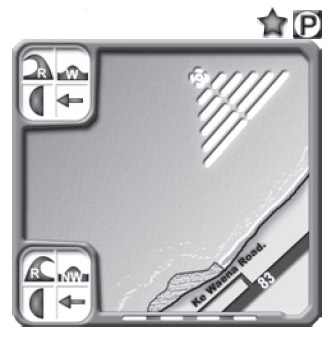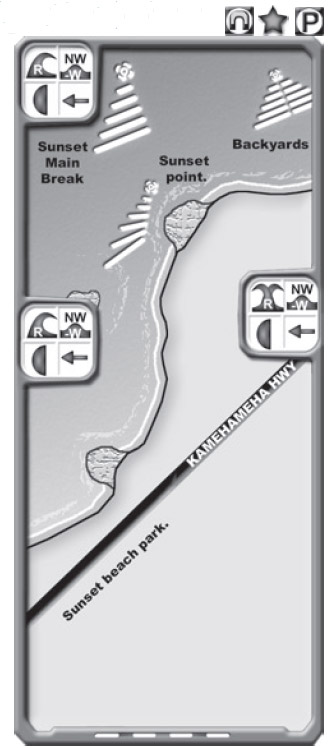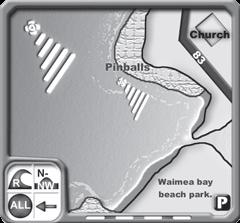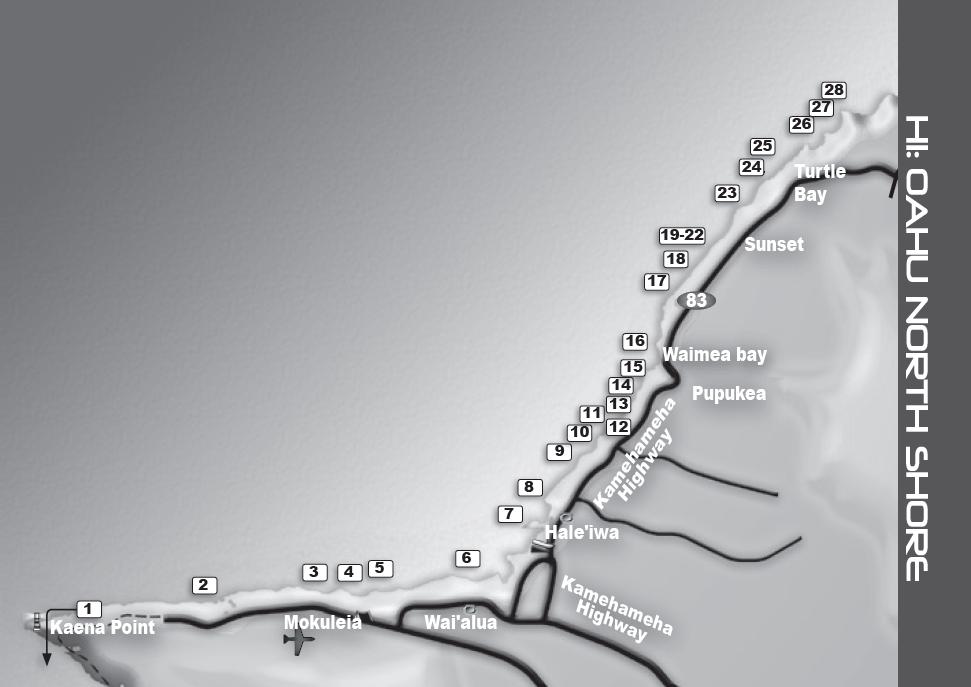Posts Tagged ‘Hawaii’
Spot of the Week: Banzai Pipeline, Hawaii
December 1st, 2011
It’s one of surfing’s longest running traditions that the final (and often world title-deciding) round of the ASP world tour is held at the awe-inspiring Pipeline. This year the final round of the Triple Crown series, the Billabong Pipe Masters takes place during the waiting period from 8th to 20th December.
In the run up to the event we take a look at the famous wave:
At the Southern end of Ehukai Beach Park. Going North from Waimea about 2 miles, small alley on left before Sunset Beach Elementary.
Pipeline; Probably the squarest barrel on earth. ..when it’s on. Pipe needs trades, and the right swell (W to NW at 4 – 25ft) to work properly.
Take one of these away and you can have a shapeless, punishing mess. The rule of thumb is; the more west the swell, the heavier and hollower the wave.
Pipeline is a series of 3 reefs working from the inside to the outside as the swell increases. First Reef: At 4 ft, you can have the
most perfect barrels followed by a short whack-able section here. The crowds at this size will frustrate, and the dropping in is blatant.
The wave is so close to the beach that spectators can get closer to the action than any other surf spot. At 6-8ft, the peak appears close to dry
sucking off the reef, and the drop is a free-fall. A mistake could see you jammed into a crack in the lava reef, but successful riders will make the
bottom turn, and stand tall in a super-wide almond shaped barrel. Then it’s a speed-race out onto the shoulder, which eventually tapers into a sandy channel.
Second Reef: From 10 or 12 ft plus, another crop of lava pushes up bombs another 100 yards out to sea. These can be mountainous
jacking peaks which reform on first reef giving 2 rides in 1. Take-offs here are more critical than any wave anywhere. Timing, commitment
and a heavy board are essential to manoeuvre into the elusive time-space window between being pushed over the back by the gusty winds
funneling up the face, and too-late drops straight to the bottom. The entire length of the wave is a full-power situation, with the lip ready to cut a surfer
down at any moment, and even the latter half of the ride can produce truck-sized barrels.
There’s anoccasional 3rd reef too, for monsters up to a much contested 30 feet. Now a tow-in domain, and quite rare to see it perfect.
Paddle-out fast, West of Backdoor. Current will sweep you East of the peak into the channel. Crowds to the extreme. Drop-ins are
the rule not the exception. Frustrated caged battery-chicken surfing. Experts only.
Backdoor: The right off the same peak as first reef, is an equally if not more heavy tube machine, with even more shallow reef and
rocks to contend with. Backdoor tubes often end in shut-down or dry-suck, and the successful surfer will make speed his friend. No
time for turns here. Works on similar swells, although likes more North than Pipe itself. Too much West in the swell, or too much
size, and it will be a dangerous close-out. From 3 to 10 ft. Crowded to the extreme. Drop-ins from body-boarders and surfers better than you.
Shallow reef with deep cracks to get stuck in. Current. Thick guillotine lips.Both these waves have claimed lives, and may be best experienced
vicariously. Try to catch them early or late season or you may not get a single wave. If you want expert tuition to help get your confidence up
(or are prepared to admit that you need some lessons), The Hawaii Surf School is based on the North Shore, on 808 638 7845. Beccy Benson and
her team of pros will hone your skills whatever your level.
Spot of the week: Sunset Beach, Hawaii
November 17th, 2011
Next week the Van’s World Cup of Surfing will be taking place at Sunset Beach, Oahu, Hawaii.
Before the event we take a look at one of the longest beaches in Oahu.
Up the Kam Hwy till you see the parking spaces on the left after Kammies. Sunset; Set of reefs dealing with
swells from N through W. Northerly swells break the wave up into different peaks, and make the place a little more
sharing as a result.
On a classic big West swell with trades, Sunset is a heavy, jacking peak that develops into a hollow, sucky, thick lipped beast.
These swells catch the trades side-offshore, and the result means heavy long boards and serious intent are required to get you
into the wave. 4-15ft. Major Rips. Crowds. Expert.
Sunset Point, further inside, is a quality R breaking at 3-6ft on NW – W swells. It can lose shape on N swells. Crowds. Intermediate.
Just East is Backyards; fickle, often shifty proposition that goes left and right, and works from 4 to 1212 ft. Currents and unpredictable
peaks absorb surfers well. Expert or tow-in.
Finally, Outside Sunset: Huge right tow-in spot when Sunset is closed out. Can work all the way through Outside Backyards, which is a
right / left outer monster too, with shallow reef under the end section. Hell-men only!
Spot of the week: Alii Beach, Hawaii
November 6th, 2011
Next week the opening event of the prestigious Vans Triple Crown of Surfing series – the Reef Hawaiian Pro – is taking place at Alii Beach, Haleiwa, Oahu, Hawaii from November 12th – 23rd 2011.
Ahead of this event we take a look at the beach where Baywatch Hawaii was filmed.
Head North up the Kam Hwy to Haleiwa. Left turn into town towards the harbor. When it’s on, it is one of the heaviest,
fastest, hollowest rights imaginable. The main peak is about 300m out to sea, and the wave forms heavy sections all the way
across to a shallow close-out spot (Toilet Bowl).
Best at 6-8 ft with prevailing Northeast trades, and Northwest to West Swell. When bigger, can get very rippy and bumpy, but quality is possible up to 10 -20ft plus. Watch locals paddle-out to gauge current and best route. Flirt into the zone to get your wave, then hang wide between sets. Beginners can check the inside shore break. Crowds; Crazy in winter. Experts only unless small.
Avalanche is a big wave arena several hundred yards further out. Lefts up to 30ft plus are not uncommon in winter. Tow-in spot except Dec-May (Whale season) Unreliable end section means that floggings are common even if you make the initial drop. Moving peak means constant paddling to re-position, and outside bombs are a constant risk. (An Avalanche of water on your head). Experts only.
Spot of the Week – Waimea Bay
December 20th, 2010
Head North from Haleiwa on the Kam Hwy, you’ll see the bay and the church. The parking lot is just before the bridge.
Waimea Bay: Justly famed big wave arena, ridden from 6-30ft plus. Waimea proper is a right hand parachute drop monster breaking on a 28ft deep reef ledge. Not the world’s longest wave, but perhaps the most exhilarating drop anywhere, followed by a massive wall section and probable annihilation by the foam ball.
Watch sets for at least 20 minutes before jump-off. Ask the lifeguards about the swell forecast; they will have incredibly accurate info from the wave buoy, and will be able to tell you when the swell will peak and how big that will be. There is even a pressure pad by Kaena Point, that gives a few minutes warning if a 30ft plus set is approaching. Wave size can increase from 8 to 20ft in a few hours.
Getting in: wait for a lull, then get in by running down the bank by the rocks at the Northern end and jumping / paddling like crazy. Keep right, the current will sweep you left into the channel. Too far left and you could be in the horrid dumpers at the South end.
Getting out: get a wave, then try to ride the foam ball back into the North end to beat the sweep and hug the rocks. This is your best bet at escaping the shore break, which is at its most spine-snapping in the middle of the bay. Watch the approaching shore break and try to get in on the back of the last wave of the set.
Crowds. Drop-ins. Experts only. If in any doubt, stay on the beach. On smaller days, Pinballs is an option on the inside. Shore break is notorious and menacing, although occasionally surfable.
Here’s more info on Oahu surf spots and surf breaks in the USA & Hawaii.
Spot of the Week – Pipeline
December 13th, 2010
Home of the Pipe Masters since 1971 (won by Wavefinder editor in chief Larry Blair in 1978 & 1979) and possibly one of the most photographed surf spots on the planet, Pipeline on Oahu’s North Shore is regarded as the world’s deadliest wave. At the Southern end of Ehukai Beach Park, going north from Waimea about 2 miles, down a small alley on the left before Sunset Beach Elementary.
Pipeline: Probably the squarest barrel on earth, when it’s on. Pipe needs trades, and the right swell (W to NW at 4-25ft) to work properly. Take one of these away and you can have a shapeless, punishing mess. The rule of thumb is; the more west the swell, the heavier and hollower the wave.
Pipeline is a series of 3 reefs working from the inside to the outside as the swell increases. First Reef: At 4ft you can have the most perfect barrels followed by a short whack-able section here. The crowds at this size will frustrate, and the dropping in is blatant. The wave is so close to the beach that spectators can get closer to the action than any other surf spot. At 6-8ft the peak appears close to dry sucking off the reef and the drop is free fall. A mistake could see you jammed into a crack in the lava reef, but successful riders will make the bottom turn and stand tall in a super-wide almond shaped barrel. Then it’s a speed race out onto the shoulder, which eventually tapers into a sandy channel.
Second Reef: From 10-12ft plus, another crop of lava pushes up bombs another 100 yards out to sea. These can be mountainous jacking peaks which reform on first reef giving 2 rides in 1. Take-offs here are more critical than any wave anywhere. Timing, commitment and a heavy board are essential to manoeuvre into the elusive time-space window between being pushed over the back by the gusty winds funnelling up the face, and too-late drops straight to the bottom. The entire length of the wave is a full-power situation, with the lip ready to cut a surfer down at any moment, and even the latter half of the ride can produce truck-sized barrels. There’s an occasional Third Reef too, for monsters up to a much contested 30 feet. Now a tow-in domain and quite rare to see it perfect.
Paddle out fast, West of Backdoor. Current will sweep you East of the peak into the channel. Crowds to the extreme. Drop-ins are the rule not the exception. Frustrated caged battery-chicken surfing. Experts only.
Backdoor: The right off the same peak as first reef, is an equally if not more heavy tube machine, with even more shallow reef and rocks to contend with. Backdoor tubes often end in shut-down or dry-suck and the successful surfer will make speed his friend. No time for turns here. Works on similar swells, although likes more North than Pipe itself. Too much West in the swell, or too much size and it will be a dangerous close-out. From 3-10ft. Crowded to the extreme. Drop-ins from body boarders and surfers better than you! Shallow reef with deep cracks to get stuck in. Current, thick guillotine lips.
Both these waves have claimed lives, and may be best experienced vicariously. Try to catch them early if late season or you may not get a single wave.
Here’s more info on Oahu surf spots and surf breaks in the USA & Hawaii.
For a view from inside the barrel, checkout this clip featuring Anthony Walsh
Session at Jaws – Nov 2010
November 30th, 2010
2nd November 2010 is a day that will never be forgotten by anyone in the surfing community and it somehow seems fitting that on that very same day, on the north coast of Maui, Jaws awoke for a quality big wave session.
Tow in at Jaws 2 Nov 2010 from Happysurfer on Vimeo.
Spot of the Week – Sunset Beach
November 25th, 2010
Site of the annual O’Neill World Cup of Surfing, Sunset Beach is another Oahu North Shore classic. Up the Kam Hwy until you see the parking space on the left after Kammies.
Sunset: Set of reefs dealing with swells from North through West. Northerly swells break the wave up into different peaks and make the place a little more sharing as a result. On a classic big west swell with trades, Sunset is a heavy, jacking peak that develops into a hollow, sucky, thick lipped beast. These swells catch the trades side off-shore, and the result means heavy longboards and serious intent are required to get you into the wave. 4-15ft. Major rips, crowds, experts only.
Sunset Point: Further inside is a quality right breaking at 3-6ft on NW-W swells. It can lose shape on north swells. Crowds, intermediate.
Just East is Backyards: fickle, often shifty proposition that goes left and right, and works from 4-12ft. Currents and unpredictable peaks absorb surfers well. Experts or tow-in.
Finally, Outside Sunset: Huge right tow-in spot when Sunset is closed out. Can work all the way through Outside Backyards, which is a right / left outer monster too, with a shallow reef under the end sections. Hell men only!
Here’s more info on Oahu surf spots and surf breaks in the USA & Hawaii.
Welcome back Parko
November 22nd, 2010
After six months on the sidelines following a horrific fin cut to his foot, Joel Parkinson won the Reef Hawaiian Pro at Haleiwa on Oahu’s North Shore. It’s been a tough up and down season for Parko, with the injury, the birth of a son and then the death of Andy Irons. The entire surfing community has got to be stoked to see Parko back and in such great form.
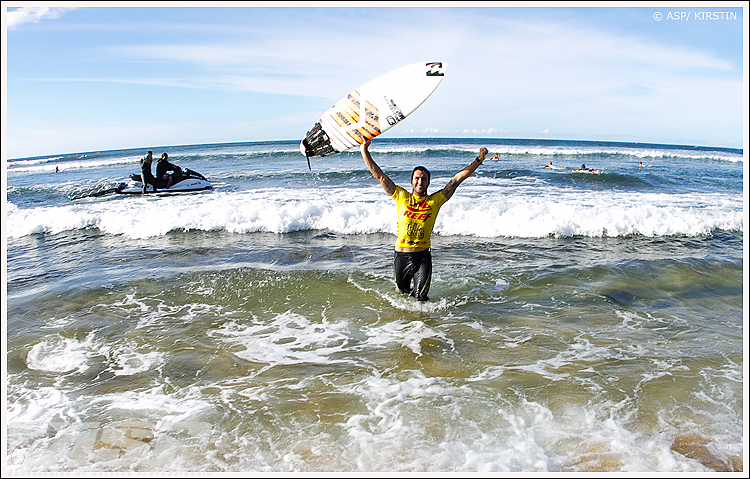
Here’s the official ASP press release:
HALEIWA, Oahu, Hawaii – (Nov. 21, 2010) — Australia’s Joel Parkinson (Gold Coast, QLD) made a brilliant return to the pro surfing stage after six months on the sidelines with injury, winning the Reef Hawaiian Pro today to take the lead in the prestigious Vans Triple Crown of Surfing series. Parkinson, 29, is the two-time defending champion of this Hawaiian series that is the final stage of the ASP World Tour. It was an emotional day for the Australian who has experienced the highs and lows of life en-route to today’s win: The birth of his son last month, the death of close friend Andy Irons two weeks ago, and debilitating injury that forced him off tour.
This week Parkinson has been in devastating form, posting the only perfect 10 of the event and the highest heat total of the competition in his opening round. His form has been on-point and on-rail for the duration and easily deserving of the $20,000 winner’s purse.
“It has been a pretty up and down year emotionally,” said Parkinson. “I cut my foot and I was out of action for six months, I didn’t surf for three months and I didn’t compete for six months. Then I had a baby son so we had some joy, and then Andy (Irons) passed. It’s been one of those years with one good thing then one bad thing. The year is almost over, we’ll get through it and I’m trying to make amends with all good things that can happen from here to December.
“Riding a wave is always one of those things that, no matter what happens in or around your life, you can still ride a wave and forget everything.
“Considering that the last few years I didn’t make a final here, to actually get a win and go to Sunset, which is one of my strengths and Pipe, where I’ve done well, it’s definitely a good start to the Triple Crown.”
Runner-up in the final was Joel Centeio (Hawaii, $10,000), the defending champion coming into the event. Third was Julian Wilson (Sunshine Coast, QLD, $5,100); and fourth was Heath Joske (Coffs Harbour, $4,900). The highest placed Brazilian surfer was Alejo Muniz (=13th); the top US surfer was Huntington Beach’s Brett Simpson (CA =13th); and the top European was Maxime Huscenot (France, =25th).
For Wilson and Joske, this was their first 6-star Prime rated final and the pair are now in the running for the JN Automotive Rookie of the Vans Triple Crown award – for the top newcomer to the series.
The 30-minute final was a relatively wave-starved affair with a total of only 11 waves ridden. Conditions over the past week of competition have ranged from double-overhead to head-high today.
Spot of the Week – Haleiwa
November 11th, 2010
 Haleiwa: Head north up the Kam Hwy to Haleiwa. Left turn into town towards the harbour. When it’s on, it is one of the heaviest, fastest, hollowest rights imaginable. The main peak is about 300m out to sea, and the wave forms heavy sections all the way across to a shallow close-out spot (Toilet Bowl). Best at 6-8ft with prevailing Northeast trades and Northwest to West swell. When bigger, can get very rippy and bumpy, but quality is possible up to 10-20ft plus. Watch locals paddle out to gauge current and best route. Flirt into the zone to get your wave, then hang wide between sets. Beginners can check the inside shore break. Crowds, crazy in winter. Experts only, unless small.
Haleiwa: Head north up the Kam Hwy to Haleiwa. Left turn into town towards the harbour. When it’s on, it is one of the heaviest, fastest, hollowest rights imaginable. The main peak is about 300m out to sea, and the wave forms heavy sections all the way across to a shallow close-out spot (Toilet Bowl). Best at 6-8ft with prevailing Northeast trades and Northwest to West swell. When bigger, can get very rippy and bumpy, but quality is possible up to 10-20ft plus. Watch locals paddle out to gauge current and best route. Flirt into the zone to get your wave, then hang wide between sets. Beginners can check the inside shore break. Crowds, crazy in winter. Experts only, unless small.
Avalanche: is a big wave arena several hundred yards further out. Lefts up to 30ft plus are not uncommon in winter. Tow-in spot except Dec-May (Whale season). Unreliable end section means that floggings are common, even if you make the intial drop. Moving peak means contant paddling to re-position, and outside bombs are a constant risk (an Avalanche of water on your head). Experts only.
Here’s more info on Oahu surf spots and others throughout the USA & Hawaii.
Oahu’s North Shore – think big
November 8th, 2010
The basics:
Few places on earth qualify for the term extreme, but this stretch of coast most definitely does. Extremely big waves, extremely shallow reef, extremely wide barrels, extremely crowded, extremely seasonal, extremely good surfers.
When to go:
The North Shore’s best conditions coincide with the winter season. Northeast trade winds combine with winter West to North swells to create perfect and often massive conditions between October and March. The closer you are to the middle of this window, the more chance you have of big perfect surf … and crowds. Bear in mind that, as an island in the middle of the largest ocean, Oahu is rarely flat, and it may pay to check it early or late season. Kona (Southwest) winds can also hit at any time or season, sometimes for a week of more, making most of this coastline on-shore. Equally, glassy mornings can occur at any time, making unusual spots perfect. Summer is traditionally small or flat, but mother nature can offer unexpected treats.
Hazards:
Big waves, heavy surfer population, reef cuts, occasional sharks, jellyfish, sea-urchins, currents, some theft, expensive beer.
